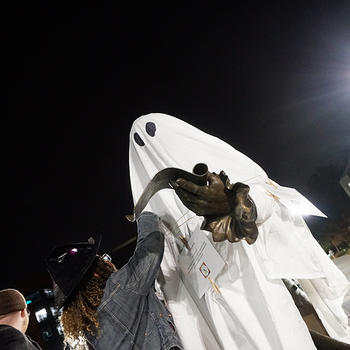It was a dark and stormy night. Students gathered beneath the golden streetlamps of Mason Pond, the ground littered with leaves.

"They say the ghost of the dead will beckon you into the pond," says the storyteller, as the crowd "oohs" in excitement.
The hosts are members of Mason’s Folklore Roundtable—a student-run organization for folklore students and enthusiasts--and this was their second annual Campus Legends and Lore Walking Tour on Halloween Eve.
"I love ghost tours, because they let you explore an area and get to know its history," said Sarah Thompson, history major and Honors College student. Thompson was one of 40 participants for this year's event. "I'm excited to get to do this one at Mason."
The tour started at The Hub and took a winding route around the Fairfax Campus to hear about local and Mason-specific folklore. The bridge through the forests between The Hub and the Aquatic and Fitness Center leads to a discussion of the infamous Bunnyman Bridge of Clifton, Virginia; a visit to the Johnson Center parlays into the telling of the folktale of Old Man Johnson—a ghost said to follow Mason’s rowing team.
As the tour highlighted, Mason boasts multiple traditions and folk beliefs, such as annual bench painting and the supposed haunting of Mason Pond. The statue of George Mason IV has its own veritable library of folkloric associations: rubbing the toes for good luck, taking a photo with George at graduation, or avoiding stepping on the plaque for fear of not graduating.
At one of the most diverse public universities in the nation, these traditions help bring the campus community together with a shared sense of Mason identity.
“Part of folklore’s function is to connect people to space and place,” said Ang DiNardo, the current president of the Folklore Roundtable and a graduate student in the folklore program. “Mason folklore allows students to feel connected to the campus and part of the community. You see someone rubbing George’s toe for luck, and it makes you feel connected to that person, even if you don’t know them.”
The tour is also a unique opportunity for Mason students to learn about folklore as an academic discipline. Along the tour, folklore students explain basic terminology used in the field and discuss theories of folklore development and its impact. Tour guests walk away knowing the difference between a “legend” and a “myth,” while also being a little more wary of nighttime excursions to Mason Pond for fear of vengeful spirits.
Mason's Department of English in the College of Humanities and Social Sciences offers the only master’s level folklore program in the Mid-Atlantic region and is home to the Journal of American Folklore, the flagship journal of the American Folklore Society.
"Everyone has folklore, even if they don't know that's what it is," said Alice Christensen, anthropology major and member of Folklore Roundtable's leadership team. "It's valuable to have a name to put to what you do in your daily life."
Partway through the 2023 tour, participants got to participate in one of Mason’s many traditions: decorating George himself on Wilkins Plaza. To gather together and engage with folklore is to keep the traditions and practices alive, and to help the community thrive. “It’s folklore in action,” said DiNardo.
George, draped in a ghostly sheet and decorated with the tales and traditions described on the tour, will hopefully be the only ghost we see this Halloween.
Related News
- April 24, 2024
- April 19, 2024
- April 19, 2024
- April 15, 2024
- April 9, 2024
